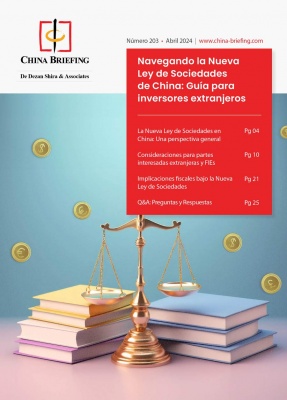China 2012: Strong Growth Forecast, No Inherent Problems
China next year – changes and trends (part one of a two-part article)
Op-Ed Commentary: Chris Devonshire-Ellis
Dec. 12 – Our firm, Dezan Shira & Associates has just finished our initial draft budgeting for 2012, and although some tweaking still needs to be carried out, the initial prognosis for the coming year seems positive. Our budgets are designed based upon the levels of performance achieved during 2011, a track record of 20 years’ operations in China providing us with plenty of precedence as concerns analysis, and the fact that we are a national business with some 12 offices throughout the country.
We consolidate our national budgets for the forthcoming year by adding together all the regional budgets planned by our various offices (which are each examined individually), discuss the details of each, make adjustments as necessary, then put them all together to see what it looks like, and overview onto that other issues that we feel we need to invest in over the course of the coming year. That becomes an operational budget as how we see the year behaving – and our track record in getting this right is pretty good – mostly as much of it is based upon definable and expected costs.
Then, to get to a targeted budget, for what we want to achieve and identify a margin to be attained as part of growth, we look at precedent in terms of growth, set targets and it’s all done. Or at least that’s the theory – I’ve never, ever, seen a budget behave bang on schedule. But after such a long time in China, it seems we’ve managed to get some consistency into the business and its expected performance. That in itself is an improvement in China, when for many years the sheer unpredictability of the country could (and often did) make budgeting for the year ahead extremely difficult. That’s not least because in emerging markets there is often something unforeseen that occurs, sending even the most meticulous budgets out of whack. In China, these have included the Asian Financial Crisis, the bird flu outbreak, and the current Global Financial Crisis. The latter has probably been the least difficult to deal with in terms of viewing it from China, but the fiscal stimuli and the impact of foreign investment certainly made the markets and economic conditions very strange for some time, and difficult to judge. A tip here is to keep sufficient reserves in place to offset any unforeseen fiscal problems, and our business has always maintained a healthy balance on hand just in case. We recommend all businesses operating in China do the same, and that includes for 2012.
That said, a pessimist could suggest that China is due for another serious problem (they have in the past tended to occur every five years) but natural disasters aside, which anyway tend to be localized, I don’t see any problems developing for China in 2012. In fact, I see instead some predictability in the business climate in China, and that has got to be welcome news. However, there are a handful of residual issues that people have been discussing, so let’s deal with them here:
The China leadership change
This will be the third leadership change I’ve lived and worked through in China. Although Deng Xiaoping was elderly, he still held the reins of power up until his death, and only then was the baton fully passed to Jiang Zemin and Zhu Rongji. Succeeded by the current incumbents Hu Jintao and Wen Jiabao nine years ago, in all cases the leadership transition passed off without a hitch. Although Western media likes to speculate, and often make things up (Jiang Zemin reported as being close to death earlier this year being a particularly insensitive example in extreme bad taste), the reality is the succession will not be an issue. It will generate plenty of column inches and guesswork about the personal and political nature of the expected new president, Xi Jinping, however, apart from the media spotlight, I do not expect any of this to affect the business climate. China will go on as before; all else is media speculation and can essentially be ignored.
China’s slowing growth
I find it astounding the number of people who feel that a 7 percent to 8 percent GDP growth rate in China is a portent for disaster. Clearly, it cannot be and especially when viewed against the growth rates expected in the United States and Europe next year. These are expected to be little more than 2 percent (and in the case of Europe, possibly worse) and the message is clear: if MNCs or other businesses want to get growth into their performances for the foreseeable future (and certainly for 2012) they have to be in Asia, and China is almost a given.
The simple reason to why China’s growth rate has fallen is also a basic mathematical equation. With the Chinese economy – now the world’s second largest – growing at such a tremendous pace for the past two decades, a slowdown has always been inevitable. As I explained to a U.S. journalist from the Boston Globe just last week, if in year one I make US$100, and in year two US$110, that’s a 10 percent growth rate. But to sustain that 10 percent growth in year three, I don’t need to make an additional US$10, I now need to make US$11, and so on ad infinitum. Continuing growth rates of 10 percent a year have long been implausible, and now the sheer economic size of China has caught up with it. GDP growth of between 7 percent and 8 percent for China 2012 will be an amazing performance, and one that should catch the eye of every Western executive. Simply put, growth is in China.
Rising employment and social welfare costs
This is an issue for smaller businesses, and many may find it too difficult to cope if they are at a financially critical stage of their business development. However, as I mentioned, in emerging markets, it pays to be aware that things can come up and bite you. Although I personally believe the whole management of the social welfare issue as concerns expatriate employees, and possibly domestic employers, has been handled very poorly by the Chinese administration, again, the reality is that these additional costs will be an absorbable burden for most established businesses. This may mean the foregoing of salary increases for many expats during 2012 as the money originally budgeted for that will now have to be swallowed up in increased social security payments, but this blip should be overcome during the course of the year as the costs get better integrated with cash flow. A nuisance? Yes. Necessary? Probably not. A big problem? No. Expats may find annual salary increases on hold for 2012, but they should be back in the equation in 12 months’ time.
Concerning rising labor costs, this affects principally the minimum salary level, which is being raised at a rate of 20 percent annually until 2015. Although this has impacted on low-margin, labor-intensive industries across China (and especially in the South), this is also a result of changing demographics and a need to ensure low-paid, unskilled workers are not exploited. Many companies affected by this have relocated to Bangladesh, Vietnam or elsewhere in emerging Asia and live on in another country. The upside of increasing wealth through rising labor costs though is an increasing consumer middle class. Bring that on – we all want to sell to China, and with an estimated 250 million considered middle class at present, and 70 million of them to Western standards – an increase in wealth throughout the Chinese population only means better quality and more opportunities to sell products and services to this dynamic market.
Part two of this series, detailing China 2012 trends, can be viewed here.
Chris Devonshire-Ellis is the principal and founding partner of Dezan Shira & Associates, a professional services firm handling foreign direct investment into Asia. The practice has been operating throughout China since 1992 and has 12 offices in the country. Please contact the firm at china@dezshira.com, download their brochure here or visit their website at www.dezshira.com.
To obtain a complimentary subscription to the China Briefing weekly e-update, containing the best of the week’s China and Asia business and investment news, please click here.
Related Reading
 Doing Business in China
Doing Business in China
Our 156-page definitive guide to the fastest growing economy in the world, providing a thorough and in-depth analysis of China, its history, key demographics and overviews of the major cities, provinces and autonomous regions highlighting business opportunities and infrastructure in place in each region. A comprehensive guide to investing in China is also included with information on FDI trends, business establishment procedures, economic zone information, and labor and tax considerations. Priced at US$40 (PDF)
- Previous Article China to Offer Incentives to Its High-Tech, Cultural Industries
- Next Article Apple Loses iPad Trademark Case in China
























